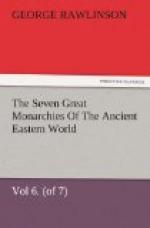The most imposing remains which seem certainly assignable to the Parthian period are those of Hatra, or El-Hadhr, visited by Mr. Layard in 1846, and described at length by Mr. Ross in the ninth volume of the “Journal of the Royal Geographical Society,” as well as by Mr. Fergusson, in his “History of Architecture.” Hatra became known as a place of importance in the early part of the second century after Christ. It successfully resisted Trajan in A.D. 116, and Severus in A.D. 198. It is then described as a large and populous city, defended by strong and extensive walls, and containing within it a temple of the Sun, celebrated for the great value of its offerings. It enjoyed its own kings at this time, who were regarded as of Arabian stock, and were among the more important of the Parthian tributary monarchs. By the year A.D. 363 Hatra had gone to ruin, and is then described as “long since deserted.” Its flourishing period thus belongs to the space between A.D. 100 and A.D. 300; and its remains, to which Mr. Fergusson assigns the date A.D. 250, must be regarded as probably at least a century earlier, and consequently as indicating the character of the architecture which prevailed under the later Parthians, and which, if Sassanian improvements had not obliterated them, we should have found upon the site of Ctesiphon.
The city of Hatra was enclosed by a circular wall of great thickness, built of large square-cut stones, and strengthened at intervals of about 170 yards by square towers or bastions. [PLATE IV. Fig. 1.] Its circumference considerably exceeded three miles. Outside the wall was a broad and very deep ditch, and on the further side of the ditch was an earthen rampart of considerable height and thickness. Two detached forts, situated on eminences, commanded the approaches to the place, one towards the east, and the other towards the north. The wall was pierced by four gateways, of which the principal one faced the east.
[Illustration: PLATE 4.]




